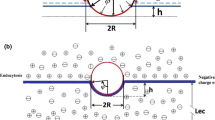Abstract
Purpose. To investigate the effects of the β-turn structure of a peptide on its permeation via the paracellular and transcellular routes across cultured bovine brain microvessel endothelial cell (BBMEC) monolayers, an in vitro model of the blood-brain barrier (BBB).
Methods. The effective permeability coefficients (Peff) of the model peptides were determined across BBMEC monolayers. The dimensions of the aqueous pores in the tight junctions (TJs) of the BBMEC monolayers were determined using a series of hydrophilic permeants. This value and the molecular radius of each peptide were used to calculate the theoretical paracellular (PP *) and transcellular (PT *) permeability coefficients for each peptide.
Results. A comparison of the theoretical PP * values with the observed Peff values was made for a series of model peptides. For the most hydrophobic peptides (Ac-PheProXaaIle-NH2 and Ac-PheProXaaIleVal-NH2; Xaa = Gly, Ile), it was concluded that the Gly-containing peptide of each pair more readily permeates BBMEC monolayers via the transcellular pathway than the Ile-containing analog. In addition, the Gly-containing peptides, which exhibit more β-turn structure, were shown to be more lipophilic than the Ile-containing peptides as estimated by the log of their l-octanol:HBSS partition coefficients (log Po/w). However, the three hydrophilic peptide pairs (Ac-TyrProXaaAspVal-NH2, Ac-TyrProXaaAsnVal-NH2, and Ac-TyrProXaaIleVal-NH2; Xaa = Gly, Ile) were found to permeate BBMEC monolayers predominantly via the paracellular pathway. No differences were observed in the Peff values of the hydrophilic peptides having higher β-turn structures as compared to the peptides lacking these structural features. In addition, the Ile-containing peptides exhibited significantly higher log Po/w values than the Gly-containing hydrophilic peptides.
Conclusions. Hydrophobic peptides that exhibit significant β-turn structure in solution are more lipophilic as measured by log Po/w, and more readily permeate BBMEC monolayers via the transcellular route than hydrophobic peptides that lack this type of solution structure. Similar secondary structural features in hydrophilic peptides do not appear to sufficiently alter the physicochemical properties of the peptides so as to alter their paracellular flux through BBMEC monolayers.
Similar content being viewed by others
REFERENCES
W. M. Pardridge (ed.). Peptide Drug Delivery to the Brain, Raven Press, New York; 1991.
K. L. Audus, P. J. Chikhale, D. W. Miller, S. E. Thompson, and R. T. Borchardt. in B. Testa (ed.), Advances in Drug Research: Volume 23, Harcourt Brace Jovanovich, London; 1992, pp. 1-64.
D. J. Begley. J. Controlled Release 29:293-306 (1994).
M. W. Brightman. Exp. Eye Res. 25:1-25 (1977).
B. Schlosshauer. BioEssays 15:341-346 (1993).
W. M. Pardridge (ed.). The Blood-Brain Barrier: Cellular and Molecular Biology, Raven Press, New York; 1993.
G. W. Goldstein and A. L. Betz. Scientific American 255:70-79 (1986).
J. D. Fenstermacher and J. A. Johnson. Am. J. Physiol. 211:341-346 (1966).
W. M. Pardridge. Physiol. Rev. 63:1481-1535 (1983).
E. G. Chikhale, P. S. Burton, and R. T. Borchardt. J. Pharmacol. Exp. Ther. 273:298-303 (1995).
W. M. Pardridge. in M. D. Taylor and G. L. Amidon (eds.), Peptide-Based Drug Design, American Chemical Society, Washington, D.C.; 1995, pp. 265-296.
W. M. Pardridge. Adv. Drug Del. Rev. 15:3-36 (1995).
W. A. Banks and A. J. Kastin. Brain Res. Bull. 15:287-292 (1985).
E. G. Chikhale, K. Y. Ng, P. S. Burton, and R. T. Borchardt. Pharm. Res. 11:412-419 (1994).
G. M. Pauletti, F. W. Okumu, and R. T. Borchardt. Pharm. Res. 14:164-168 (1997).
F. W. Okumu, G. M. Pauletti, D. G. Vander Velde, T. J. Siahaan, and R. T. Borchardt. Pharm. Res. 14:169-175 (1997).
S. Gangwar, S. D. S. Jois, T. J. Siahaan, D. G. Vander Velde, V. J. Stella, and R. T. Borchardt. Pharm. Res. 13:1657-1662 (1996).
G. M. Pauletti, S. Gangwar, F. W. Okumu, T. J. Siahaan, V. J. Stella, and R. T. Borchardt. Pharm. Res. 13:1615-1623 (1996).
G. T. Knipp, D. G. Vander Velde, T. J. Siahaan, and R. T. Borchardt. Pharm. Res. 14:1332-1340 (1997).
K. L. Audus and R. T. Borchardt. Pharm. Res. 3:81-87 (1986).
K. L. Audus and R. T. Borchardt. Ann N. Y. Acad. Sci. 507:9-18 (1987).
J. B. M. M. van Bree, A. G. de Boer, M. Danhof, L. A. Ginsel, and D. D. Breimer, J. Pharmacol. Exp. Ther. 247:1233-1239 (1988).
A. Adson, T. J. Raub, P. S. Burton, C. L. Barsuhn, A. R. Hilgers, K. L. Audus, and N. F. H. Ho. J. Pharm. Sci. 83:1529-1536 (1994).
K. L. Audus, L. Ng, W. Wang, and R. T. Borchardt. in P. L. Smith, R. T. Borchardt, and G. Wilson (eds.), Models for Assessing Drug Absorption and Metabolism, Plenum Press, New York; 1996, pp. 239-258.
G. T. Knipp, N. F. H. Ho, C. L. Barsuhn, and R. T. Borchardt. J. Pharm. Sci. 86 (1997). In press.
T. J. Raub, S. L. Kuentzel, and G. A. Sawada. Exp. Cell Res. 199:330-340 (1992).
J.-H. Tao-Cheng, Z. Nagy, and M. W. Brightman. J. Neuroscience 7:3293-3299 (1987).
J. Laterra, C. Guerin, and G. W. Goldstein. J. Cell. Physiol. 144:204-215 (1990).
D. Eisenberg, M. Wesson, and W. Wilcox. in G. Fasman (ed.), Prediction of Protein Structure and the Principles of Protein Conformation, Plenum Press, New York; 1989, pp. 635-646.
G. Wilson, I. F. Hassan, C. J. Dix, I. Williamson, R. Shah, M. Mackay, and P. Artursson. J. Controlled Release 11:25-40 (1990).
Author information
Authors and Affiliations
Corresponding author
Rights and permissions
About this article
Cite this article
Sorensen, M., Steenberg, B., Knipp, G.T. et al. The Effect of β-Turn Structure on the Permeation of Peptides Across Monolayers of Bovine Brain Microvessel Endothelial Cells. Pharm Res 14, 1341–1348 (1997). https://doi.org/10.1023/A:1012104301773
Issue Date:
DOI: https://doi.org/10.1023/A:1012104301773




